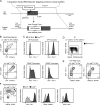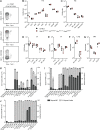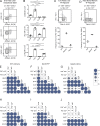Multi-transcription factor reporter mice delineate early precursors to the ILC and LTi lineages
- PMID: 33104170
- PMCID: PMC7590509
- DOI: 10.1084/jem.20200487
Multi-transcription factor reporter mice delineate early precursors to the ILC and LTi lineages
Abstract
Transcription factor (TF) reporter mice have proved integral to the characterization of murine innate lymphoid cell (ILC) development and function. Here, we implemented a CRISPR/Cas9-generated combinatorial reporter approach for the simultaneous resolution of several key TFs throughout ILC development in both the fetal liver and adult bone marrow. We demonstrate that the Tcf7-expressing early innate lymphoid precursor (EILP) and the common helper ILC precursor (CHILP) both contain a heterogeneous mixture of specified ILC and lymphoid tissue inducer (LTi) precursors with restricted lineage potential rather than a shared precursor. Moreover, the earliest specified precursor to the LTi lineage was identified upstream of these populations, before Tcf7 expression. These findings match dynamic changes in chromatin accessibility associated with the expression of key TFs (i.e., GATA3 and RORγ(t)), highlighting the distinct origins of ILC and LTi lineages at the epigenetic and functional levels, and provide a revised map for ILC development.
© 2020 Kasal and Bendelac.
Conflict of interest statement
Disclosures: The authors declare no competing interests exist.
Figures












Similar articles
-
Differential Expression of the Transcription Factor GATA3 Specifies Lineage and Functions of Innate Lymphoid Cells.Immunity. 2020 Jan 14;52(1):83-95.e4. doi: 10.1016/j.immuni.2019.12.001. Epub 2019 Dec 24. Immunity. 2020. PMID: 31882362 Free PMC article.
-
Lymphoid tissue inducer-A divergent member of the ILC family.Cytokine Growth Factor Rev. 2018 Aug;42:5-12. doi: 10.1016/j.cytogfr.2018.02.004. Epub 2018 Feb 13. Cytokine Growth Factor Rev. 2018. PMID: 29454785 Free PMC article. Review.
-
Single-cell analysis defines the divergence between the innate lymphoid cell lineage and lymphoid tissue-inducer cell lineage.Nat Immunol. 2016 Mar;17(3):269-76. doi: 10.1038/ni.3344. Epub 2016 Jan 18. Nat Immunol. 2016. PMID: 26779601 Free PMC article.
-
Polychromic Reporter Mice Reveal Unappreciated Innate Lymphoid Cell Progenitor Heterogeneity and Elusive ILC3 Progenitors in Bone Marrow.Immunity. 2019 Jul 16;51(1):104-118.e7. doi: 10.1016/j.immuni.2019.05.002. Epub 2019 May 22. Immunity. 2019. PMID: 31128961 Free PMC article.
-
Protocols for Innate Lymphoid Cell Phenotypic and Functional Characterization: An Overview.Methods Mol Biol. 2020;2121:1-6. doi: 10.1007/978-1-0716-0338-3_1. Methods Mol Biol. 2020. PMID: 32147781 Review.
Cited by
-
ROR: Nuclear Receptor for Melatonin or Not?Molecules. 2021 May 4;26(9):2693. doi: 10.3390/molecules26092693. Molecules. 2021. PMID: 34064466 Free PMC article. Review.
-
Group 1 ILCs: Heterogeneity, plasticity, and transcriptional regulation.Immunol Rev. 2024 May;323(1):107-117. doi: 10.1111/imr.13327. Epub 2024 Apr 2. Immunol Rev. 2024. PMID: 38563448 Free PMC article. Review.
-
ILC2s - development, divergence, dispersal.Curr Opin Immunol. 2022 Apr;75:102168. doi: 10.1016/j.coi.2022.102168. Epub 2022 Feb 14. Curr Opin Immunol. 2022. PMID: 35176675 Free PMC article. Review.
-
Naïve Primary Mouse CD8+ T Cells Retain In Vivo Immune Responsiveness After Electroporation-Based CRISPR/Cas9 Genetic Engineering.Front Immunol. 2022 Jun 30;13:777113. doi: 10.3389/fimmu.2022.777113. eCollection 2022. Front Immunol. 2022. PMID: 35844563 Free PMC article.
-
Multi-modular structure of the gene regulatory network for specification and commitment of murine T cells.Front Immunol. 2023 Jan 31;14:1108368. doi: 10.3389/fimmu.2023.1108368. eCollection 2023. Front Immunol. 2023. PMID: 36817475 Free PMC article. Review.
References
-
- Chea, S., Schmutz S., Berthault C., Perchet T., Petit M., Burlen-Defranoux O., Goldrath A.W., Rodewald H.-R., Cumano A., and Golub R.. 2016. Single-Cell Gene Expression Analyses Reveal Heterogeneous Responsiveness of Fetal Innate Lymphoid Progenitors to Notch Signaling. Cell Rep. 14:1500–1516. 10.1016/j.celrep.2016.01.015 - DOI - PubMed
Publication types
MeSH terms
Substances
Grants and funding
LinkOut - more resources
Full Text Sources
Molecular Biology Databases
Miscellaneous

